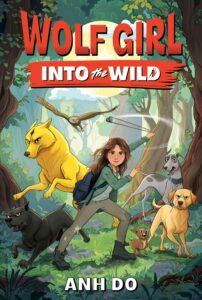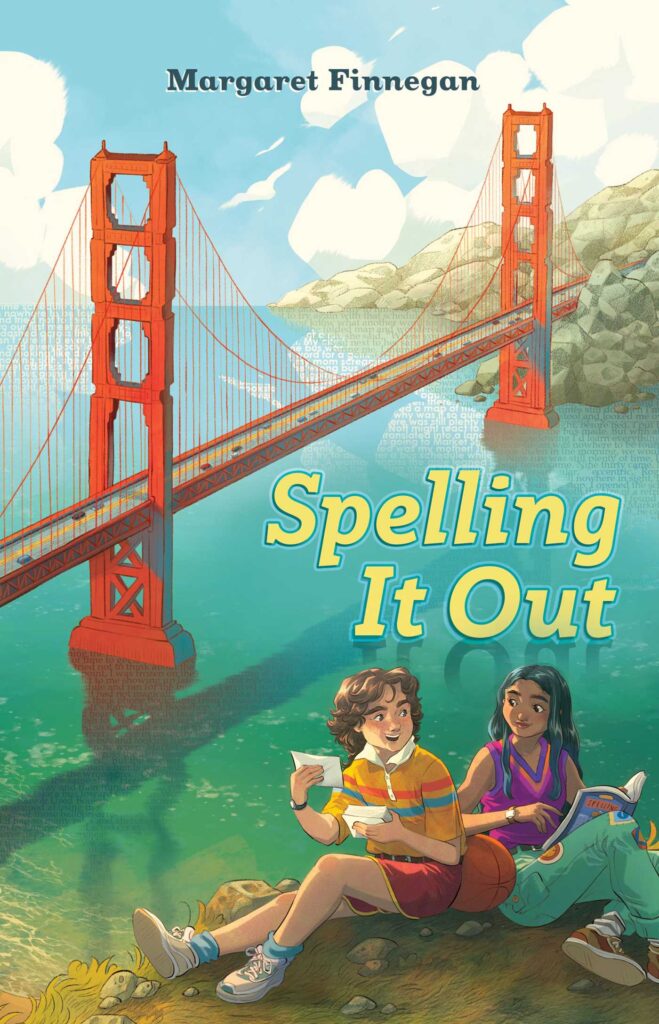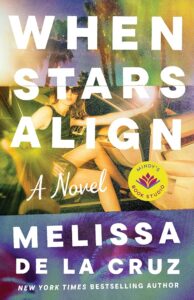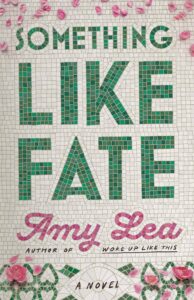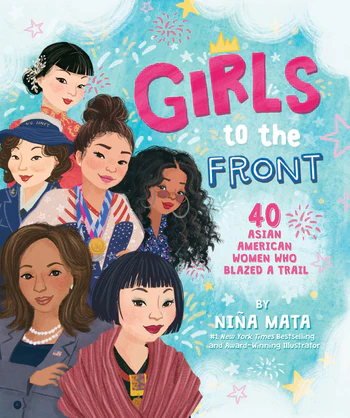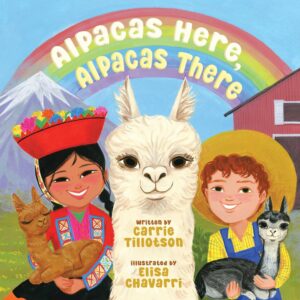An unknown threat forces Gwen and her family and everyone she knows to flee. Packing bare essentials, they set out in their car, and so does everyone else from their town. When the threat catches up to them, they set out on foot. Gwen’s parents tell her to run as fast as she can towards the woods without looking back. But when she finally tires, she realizes she’s all alone. Except, that is, for a puppy.
Soon a whole group of dogs, separated from their owners, has gathered into a pack, with Gwen as their leader helping them find food and shelter. She learns how to survive and hopes someone will come to find her. When years pass without her seeing another soul, she and her animal friends set off in search of answers.
Wolf Girl Into the Wild by Anh Do is an adventure tale for young readers that lets them consider what it takes to survive on your own. The book is the first in a series and ends on a cliffhanger. While I would have liked more info about the threat and why it took the community by surprise, as well as why Gwen waited so long to go looking for her family and other survivors, I imagine young readers aged 9 to 12 won’t have a problem with that.
The author provided a copy of this title in exchange for my honest review.
Ben Bellini gets the Spelling Bee bug when he becomes his school’s champ and advances to regionals. That’s where he finds out that people take the competitions seriously, and most contestants study for them. Ben’s friends don’t really get his newfound interest, which makes him unsure if he wants to pursue it. That is, until his grandmother invites him to spend the summer with her in San Francisco and train with a professional spelling coach.
But Ben finds that all is not as he expected when he arrives in the city. His grandma frequently forgets things, the spelling coach is kind of a bully, and he befriends a girl at the library who is also spending her summer studying spelling. As the summer goes on, he gains confidence by being in charge of getting himself around town and making sure he and his grandma have food to eat.
Yet when all his relationships start to spiral out of control, Ben will need to configure out what’s most important to him as well as how to ask for help when he needs it.
Spelling It Out by Margaret Finnegan is a tender coming-of-age story about a boy who isn’t sure of himself and his evolving relationships with his friends and family. Ben really likes spelling even though he thinks his friends see it as nerdy. He likes the freedom he has to come and go as he needs to in the city without his grandma, but he worries about the times she forgets he needs her to take him somewhere. He likes spending time at the library with Asha, but she’s working through friendship issues of her own.
Over the weeks Ben learns a lot about himself, which helps him figure out the right thing to do when a crisis occurs. There are lots of issues for moms and daughters to discuss in Spelling It Out. I recommend it for ages 9 to 12.
Also, if your inclined to learn more, check out info on the 100-year anniversary of the Scripps National Spelling Bee. Plus, the author has some fun activities to check out on her website.
The author provided a copy of this title in exchange for my honest review.
Miranda, Germaine, and Sicily met as teens on the set of a popular kids show. They basked in the attention they received, though their outward success and wild times captured by paparazzi hid the challenges they went through in their private lives. As they aged their troubles only grew.
Miranda struggled with alcohol, drugs, and superficial relationships. Germaine’s every movement and all of her money was controlled by her conservative parents. Sicily’s extended family pressured her to provide an upscale lifestyle for everyone until the pressure upended her life. One thing remained the same: their commitment as friends to each other.
Where Stars Align by Melissa de la Cruz tells the story of how these friends navigate personal and professional setbacks on the road to becoming the people they want to be. Fans of pop culture will recognize similarities between their situations and those of some real-life child stars. It also provides a look at how fame can shine a particularly harsh light on female performers, criticizing them for behaviors that male performers get a pass for, which should make for good discussion in a book club.
The author provided a copy of this title in exchange for my honest review.
It’s not unusual for kids (or adults) to not know what to say when they meet someone with an obvious disability. Author Katie Mazeika wants to change that with her picture book, Maybe Just Ask Me!
The story follows Mazie, a new girl at school who wears an eye patch and a head scarf. When she shows up for the first day a lot of kids notice her, but no one talks to her. At recess, the wind blows her scarf from her head, revealing that she’s bald. That gets the kids talking about why she looks the way she does.
They guess that she could be a pirate, or a circus performer, or has been to outer space. Mazie has a hard time speaking up to tell them the truth. When she finally finds her voice, she tells everyone that if they really want to know what happened, they should just ask her. And then she tells her story.
A note at the end form the author explains that the story is inspired by her own childhood. At three, Mazeira had cancer and had to have her eye removed. After many surgeries and chemotherapy, she started school with no hair and an eye patch. She heard kids whispering about her, but no one asked.
Even today, she says, people believe they are being polite when they don’t ask. But she feels it’s better to ask questions and see people for who they are. “Curiosity, with kindness,” she says, “should always be allowed.”

Also included at the back of the book is Mazeika’s personal list of things people can do to be supportive of people like her. Maybe Just Ask Me! can help open a conversation between parents and their kids about many things they are curious about, and help people find a kind way to interact with people they see with disabilities.
Interested in learning more? Here’s a link to a meet-the-author-interview at Teaching Books.net. You can also find a curriculum guide and other materials at the author’s website, KatieMazeika.com.
The author provided a copy of this title in exchange for my honest review.
Intro to guest post: My two daughters found very different approaches to a love of reading when they were young. One loved fiction, mostly fantasy and historical, particularly if it made her laugh. The other gravitated to nonfiction. Stories about real animals and nature and how things work were interesting to her, and they also sometimes made her laugh. Today’s guest post from Ann McCallum Staats, author of several nonfiction titles for children, talks about how to turn what could be dry and uninteresting subjects into something fun for kids to read. And making reading fun, in my opinion, is what will keep kids reading throughout their lives.
You can find out more information about Staats and her work at her website: annmccallumbooks.com.
The Enticing Spice of Kidlit Nonfiction
A dusty textbook. A list of yawn-inducing facts. A long and involved monologue with choke-in-your-throat, overly academic jargon. To most people, that kind of reading does NOT sound like fun. It’s certainly not something to look forward to during family reading time. At least, that is true in my household … which is why I take a different approach when writing nonfiction for young people.
First, though, is why I think nonfiction is a gateway from the reluctant reader to one who can’t wait to open that next delicious book. And also how kids can be just as enthused about reading about rocks or plants or a person from history as they might be about more flashy topics. As a former teacher, I was often given a curriculum that could have been boring IF I didn’t come at it in a fresh and fun way. My job then with teaching and now with books was and is to make any topic unputdownable. I firmly believe that most kids are highly curious. How many adults have seen a child engrossed in an ant’s progress or have been asked why question after why question? When given time to ponder and explore, humans are innately inquisitive. Let’s face it, we’re fascinated with the why of things.
That brings us to the allure of nonfiction, books that, if done right, are deeply satisfying. But what is it about these books that will pull a child away from endless screen time? It helps, of course, to have an enticing title and a cover that’s inviting. Here are some examples: Almost Underwear: How a Piece of Cloth Traveled from Kitty Hawk to the Moon and Mars by Jonathan Roth; Butt or Face? by Kari Lavelle; or Mummies Unwrapped by Victoria England and Tom Froese (illustrator). Intriguing, right?
My latest book is called Fantastic Flora: The World’s Biggest, Baddest, and Smelliest Plants. When I set out to write about plants, it started as a challenge to myself. How could I make that lowly blade of grass, that collection of leafy weeds, or that other greenery we walk past every day more than ho-hum? When I hit upon the organization and used ‘est’ adjectives, I had a hook into my audience. Then, after doing a little research, I became more than hooked myself. I mean, seeds that explode? Leaves that look like stones? Berries so fatal that eating just a few can stop your heart? Wow. I had the material, and now I had to share it in an engaging way that was more than just naming the facts.
Key to this was a great set-up. I wanted kids to be so smitten that they would keep reading. One strategy included comparison. In one chapter I pit a ginkgo tree against a T-rex. Who do you think wins? Hint: what can you see today, ginkgo trees or T-rexes? I also made use of opposites. “Crackle. Hiss. Flames sizzle … Will the fire spell disaster for these trees that are older than the invention of paper? No, just the opposite …” This chapter shares how a moderate fire is actually a good thing for the mighty giant sequoia. Or, what about telling a story, as I did in the case of the Venus flytrap. “Closer. Closer. A plump spider is minding its own business as it climbs over a Venus flytrap plant. But it’s dinnertime, and if this plant had a stomach, it would be growling …” If you were to keep reading, you’d find that things do not turn out well for the spider!
The bottom line to all of this is that, while I didn’t start out that way, I’ve become a huge fan of nonfiction. If done right, it can evoke emotion, capture one’s imagination, and keep one reading until the wee hours. Try it—nonfiction may very well be your next favorite thing.
Loren, known as Lo, comes from a long line of psychic women who have visions of their soulmates before they meet. Her own mom died when she was young, and she’s never had a vision of her own until her freshman year of college. The image she sees confirms for her that she’ll meet her soulmate during a summer backpacking trip in Italy.
On her first stop, Venice, she is rescued from a runaway trolley by Caleb, and she’s sure he’s the one. But how does she get to know him without scaring him off with the news of her vision? And how does she reconcile being with Caleb when her feelings for her long-time best friend Teller, who is on the trip with her, seem to be growing? That’s what Lo has to find out in Something Like Fate by Amy Lea.
The book seems ripe for an adaptation to a rom-com movie, and all the plot points are there: a girl who misses her mom, her dad who doesn’t like to talk about the past, a guy who’s always been seen as a best friend who morphs from nerd to hottie after high school, and a new, exciting love interest.
There’s also the dreamy location. Lo spends time in Venice, Florence, Tuscany, Rome, and on the Amalfi Coast, retracing most of the stops her mom and aunt went to before she was born. Along the way, Lo finds things out from her family that she didn’t know about her mom, her aunts, her dad, and more. And Lo debates what it means to be with someone, and how relationships and affections can grow. Something Like Fate also gives a nod to movie rom-coms, with Lo and Teller quoting lines from the multiple films they have watched together as well as her expectations of “meet cute” scenarios.
While I would have preferred less detail about Lo’s life with Teller before their trip, sometimes her reflections last longer and cover more mundane details than I prefer, in general I thought the story was interesting and fun and provided a few twists that I didn’t see coming even though I guessed the eventual outcome.
The publisher provided a copy of this title in exchange for my honest review.
As a Filipina American girl, Nina Mata did not know much about Asian American women who stood out for their actions. As an author and illustrator, she has set out to provide such a guide for her daughter and the current generation of girls with Girls to the Front: 40 Asian American Women Who Blazed A Trail.
In a foreword about her illustrations, Mata drew portraits that she says, “look at us as if they’re making eye contact with the reader, because I believe eye contact helps us focus in on the conversation.” Indeed, it feels as though it’s easier to know each of the women profiled because of this.
Women profiled include some well-known today, like author Amy Tan, gymnast Suni Lee, and presidential candidate Kamala Harris. Others blazed trails in the past, like Mary Tape, who fought for the right to have her Chinese American daughter attend public school in San Francisco during the 1880s. Also, Patsy Mink, who became the first woman of color to be elected to the U.S. Congress when she won a seat in the House from Hawaii in 1964.
Additional women of achievement are listed in the back, along with a glossary of terms helpful to understanding some of the history mentioned. And Mata includes a little bit about herself in the same style as the other women profiled.
One of things we learn about her is that she was once told it was imperative for her to use her voice, which she thought meant she was destined to be a performer. Now, she understands that there’s more than one way to use her voice. I’d say bringing attention to these women who have been left out of most history books is one of those ways.
I recommend Girls to the Front for readers aged 9 to 12.
The publisher provided a copy of this title in exchange for my honest review.
Who doesn’t love alpacas? The cute animals with big eyes, long necks, and fluffy bodies attract attention whether seen in fields or farms. And of course, their wool keeps people warm when used to make things like sweaters, ponchos, gloves, and socks.
Alpacas Here, Alpacas There, a picture book written by Carrie Tillotson, lets kids in on the coziness of these creatures while also finding out more about their history and how they are farmed today.
In a hybrid style, Tillotson weaves a tale that can be read as a bedtime story to younger children who will appreciate the rhythm of the poetic words that run across the top of the page.
Nonfiction text below reveals how alpacas were first domesticated in the Andes Mountains, thousands of years ago. People in South America still farm them, as do people in North America. The text reveals much about alpacas and farming practices in both places, including the fact that baby alpacas are called crias, and that mothers and newborns hum as a way to bond and find each other.
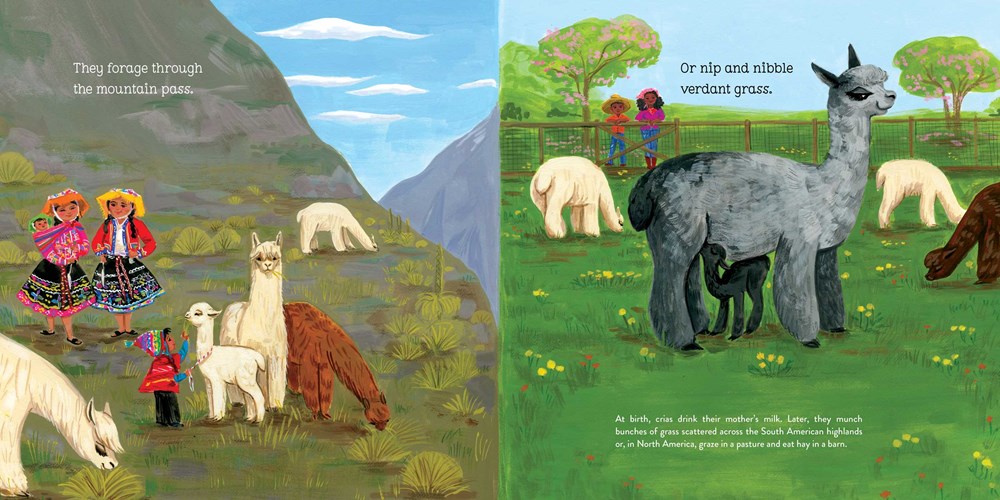
Elisa Chavarri’s illustrations emit warmth and softness, which complements the actual characteristics of the animals. The back of the book includes more facts about alpacas, how they are raised, other species like llamas, and a glossary of terms.
Alpacas Here, Alpacas There can provide different information over many readings, which is sure to make it a favorite with both parents and children.
The author provided a copy of this title in exchange for my honest review.

